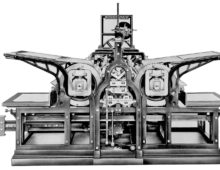Animating the Merthyr Rising with The Regimental Museum of the Royal Welsh and Christ College Brecon
July 1, 2021 - Kate McNab in News & Blog Posts
The Education Department of the Regimental Museum of the Royal Welsh, and Christ College Brecon, came together to produce a stop-motion animated film depicting the Merthyr Rising of June 1831.
Find out how to make your own stop-motion animation in the classroom (or at home) here.
Inspiration
In June 1831, a popular uprising began in Merthyr Tydfil, with an angry crowd calling for parliamentary reform to stop the exploitation of workers by industry owners. The uprising of the ironworkers and coalminers in Merthyr Tydfil, fighting for their rights against ruthless industrialists became known as the Merthyr Rising. It inspired others to follow, triggering nationwide rebellion and finally resulting in the establishment of trade unions and the beginnings of Socialism.
During the Merthyr Rising, the museum building was used as a barracks for the soldiers of the Argyll and Sutherland Highlanders who were brought in to quell the rioters. Christ College school was founded in 1541. Pupils there in 1831 would have seen the soldiers around town and been aware of the troubles.
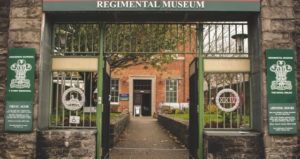
The school made the decision to study the Merthyr Rising, and create a stop-motion animation as part of the Local History aspect of the Curriculum. Some of the Year 9 students involved in the making of the film were from Merthyr Tydfil itself. They were particularly interested in the story of the execution of Richard Lewis, known as Dic Penderyn, who was wrongly accused of stabbing a soldier – Donald Black – during the uprising.
Generating Ideas
Due to COVID restrictions, teaching about the Merthyr Rising had to take place virtually and students were supported to carry out their research at home.
The students engaged in a virtual learning session from Cyfartha Castle Museum in Merthyr Tydfil and were introduced to artefacts and paintings linked to the Merthyr Rising. They also used objects from the Revolutionary collection for their research, such as the Tipstaff used to arrest Dic Penderyn and the Red Flag.
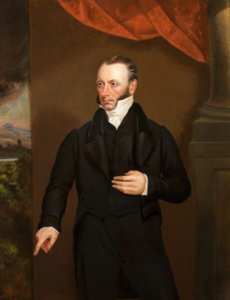
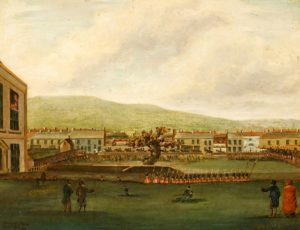
Images – L: William Crawshay II (1788-1867) (Cyfartha Castle Museum) R: Penry Williams’ (1802-1885) Merthyr Riots
Ironmaster and owner of the Merthyr Tydfil ironworks, William Crawshay II was known as the ‘Iron King’. His ironworks was the largest in Great Britain at the time and his immense wealth led to the building of the Cyfartha Castle as his home. Cuts in the pay of his workers contributed to the Merthyr Rising.
It is believed that the Merthyr Rising was the first time the red flag of revolution was flown as a symbol of workers’ revolt. The story tells how a white flag was dipped in calf’s blood and held high above the protestors’ heads. A loaf of bread was impaled on the staff as a symbol of the basic needs of the protestors.
When the students were allowed to return to school, they visited The Regimental Museum of the Royal Welsh to discover more about the lives and soldiers in the Age of Revolution.
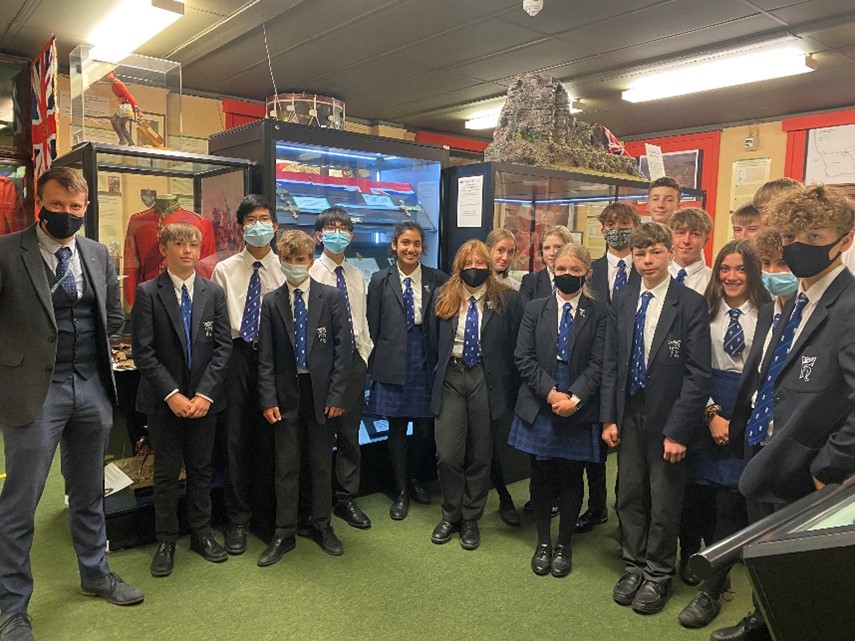

Flintlock Musket, the ‘Brown Bess’, Principal weapon of the British Army 1722-1838 (The Regimental Museum of the Royal Welsh)
In addition, the students watched a 30-minute BBC Wales archive film: Crimesolver: Dic Penderyn, hero or villain (2006). This analytical documentary looked at the riots from differing perspectives and showed the opinions of local people in Merthyr Tydfil.
Exploring Animation
The students worked with Cardiff-based filmmaker William Osborne of LOTW studios to create their animation. The students and staff were thoroughly engaged by his online tutorial on creating a stop-motion animation. William talked about his early experiences of filmmaking and showed students his first attempts as a young teenager. This was followed by an in-depth guide to methods, resources and suitable software.
Further inspiration and practical advice came from watching a short video tutorial by Faye Maybe.
Planning and Developing

Year 9 Art Class at Christ College
Storyboarding
The students produced individual storyboards depicting the riots and the demise of Dic Penderyn. These were produced at home during Lockdown. Once the students were able to return to school, ideas were shared and decisions were made as to the final composition of the animation.
Creating the set
The ‘set’ for the unfolding action was built on two levels:
• Background comprising a series of watercolour sketches.
• Foreground using jointed, paper puppets and jointed silhouettes.
Background
The students created watercolour sketches using images from the Cyfartha Castle art collection and from local history reference material as inspiration. These formed the backdrop to the drama.


Images – L: Iron works in Merthyr Tydfil circa 1831 (Cyfartha Castle). R: Student’s watercolour of a typical street in Merthyr Tydfil in 1831
Several watercolour sketches were linked to form the Background
Foreground
The Foreground comprised a series of animated characters, some as silhouettes and the others painted in watercolours. Both were cut out and disjointed, the body parts then reattached using coiled wire. Initially, split pins were used to join the limbs to facilitate movement. These were too bulky and highly visible so tiny pieces of coiled wire and masking tape replaced them.

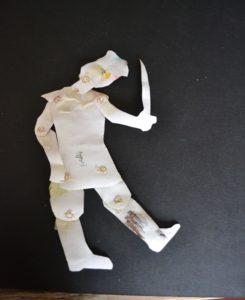
Puppet: front and back views showing wire joints
Students used their research skills to find images from the period of the Merthyr Rising and used them as reference for producing their watercolour character images.
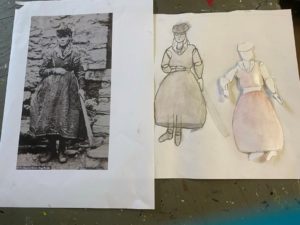
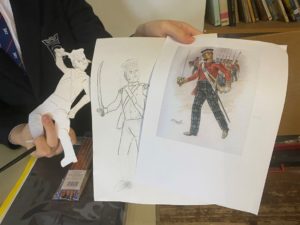

The students combined skills acquired in Performing Arts’ lessons with their photographic knowledge to create ‘live action’ silhouettes. Against a white backcloth, the students adopted individual and group poses which they photographed.
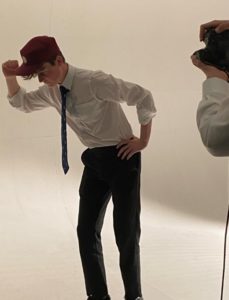
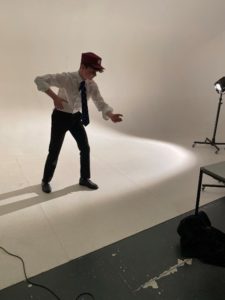
The photos were backlit to create silhouettes and cut out, ready to form scenes of chaos and insurrection, and to be used as powerful images for film’s the start and end slides.
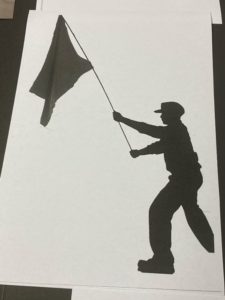

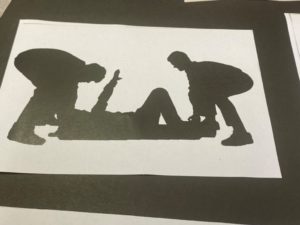
A piece of glass was placed on top of the background and the puppets placed on top, enabling them move more freely and creating a 3D effect.
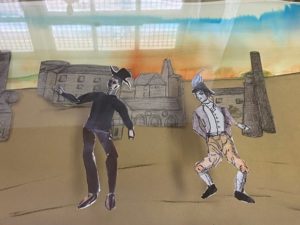
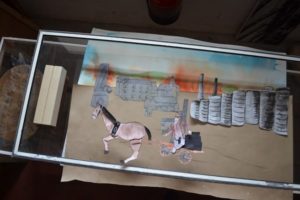
Filming
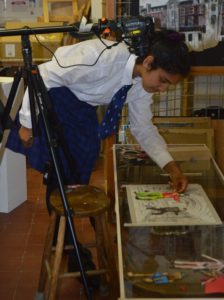
The students used a digital camera to capture multiple frames, moving the arms, legs and heads of the characters a millimetre at a time – a lengthy process. The camera was set up using a tall tripod with a boom arm to keep the camera in the same position, facing down over the scene set-ups. They used artificial lighting to keep this constant throughout the final film.
They used Adobe Premiere Pro to edit the frames together into an animation and add transitions between each scene. They tried different frames-per-second speeds and settled on 12 frames per second to make the animation look as smooth as possible.
Script and voiceover
The voiceover was delivered by a student from the same area of Merthyr Tydfil that many of the workers had lived in. The students felt he had a rich, rolling and sonorous delivery which would complement the evocative language of the script.
Using their original storyboards, the students discussed key ideas and motifs, probable running times of each scene and how the silhouettes could be used to bridge the transition from one scene to the next. A key challenge was to compose a script that trod the fine line between a coherent and flowing story and precise historical detail.
A big point of discussion was what sort of message the script should end with. The Merthyr Rising did have a big impact on world history, but it could also be viewed as having failed to improve the lives of workers in the short-to-medium term as it was violently crushed.
Originally, the students had planned to end the film with the head of Dic Penderyn falling in despair at the prospect of his own demise, but this felt too bleak. The students decided that the red flag of the workers was central to how they saw the story, just as the flag itself had become central to workers’ movements all over the world. They arrived at the idea of a solitary worker raising the flag in a defiant gesture, representing that, although the attempts of the people of Merthyr Tydfil to better their lives ‘died’, in the short term, with Dic Penderyn, the aspirations and symbols within their struggle would be reborn and used in countless future struggles around the globe.
With special thanks to:
The students of Year 9, Christ College Brecon
Deirdre Houghton: Head of Art, Christ College Brecon
Peter Griffiths: Head of Photography
Robin Francis: Head of History
Ruth Allen: Head of Faculty (Teaching and Learning Skills)
William Osborne: LOTW Studios
Janet Holcroft, Education Officer, Regimental Museum of the Royal Welsh, and project leader
Amanda Rosewarne: Curator (interim), Regimental Museum of the Royal Welsh
Ben Price: Education Officer, Cyfartha Castle Museum
Chris Parry: Curator, Cyfartha Castle Museum


